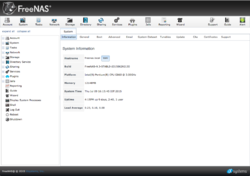TrueNAS: Difference between revisions
→See also: sp |
freenas 8 |
||
| Line 78: | Line 78: | ||
* [[Uninterruptible power supply|UPS (Uninterruptible power supply)]] support |
* [[Uninterruptible power supply|UPS (Uninterruptible power supply)]] support |
||
* [[Time Machine (Mac OS)|Apple Time Machine]] support |
* [[Time Machine (Mac OS)|Apple Time Machine]] support |
||
== Development Fork == |
|||
Starting with FreeNAS 8, the developers rewrote the product. The newer versions of FreeNAS have much more hardware requirements such as 4Gb of RAM to run [[ZFS]]. The older version of FreeNAS forked to a different project called NAS4Free, which maintains the minimal hardware requirements useful for older PCs. |
|||
== Awards == |
== Awards == |
||
Revision as of 18:44, 19 October 2012
 Screenshot of FreeNAS WebGUI | |
| Developer(s) |
|
|---|---|
| Stable release | 8.2.0
/ 20 July 2012 |
| Repository | |
| Operating system | FreeBSD |
| Platform | i386/IA-32 and x86-64 |
| Available in | |
| Type | Computer storage |
| License | BSD license |
| Website | freenas |
FreeNAS is a free network-attached storage server, supporting: CIFS (Samba), FTP, NFS, rsync, AFP protocols, iSCSI, S.M.A.R.T., local user authentication, and software RAID (0,1,5), with a web-based configuration interface. FreeNAS takes less than 64 MB once installed on CompactFlash, hard drive or USB flash drive. FreeNAS is currently distributed as an ISO image and in source form. Through version 7.x, it was possible to run FreeNAS from a Live CD, with the configuration files stored on an MS-DOS-formatted floppy disk or USB thumb drive. There is also a VMware disk image available (Last updated in 2006).[1] With the release of 8.x, Live CD is not currently supported. FreeNas 8.x needs to be installed on a Compact Flash, USB, or dedicated hard drive. Using the dedicated hard drive will use that drive just for the operating system, and files cannot be stored on it.
The minimal FreeBSD 7.2 distribution, web interface, PHP scripts, and documentation are based on m0n0wall. FreeNAS is released under the BSD license. It was reported December 2009 that FreeBSD based development would be halted and put into "maintenance-only mode" with Debian Linux as the new development target OS.[2] This decision was reverted shortly afterwards, when iXsystems offered to sponsor the further development of FreeNAS.[3][4]
Features
- Protocols: CIFS (via Samba), TFTP, FTP, NFS, SSH, rsync, AFP, UPnP, BitTorrent, and iTunes.
- Extensions (plug-ins) for: SlimServer, Xbox Media Stream Protocol.
- rsync server, client and local sync.
- Unison support. (only in legacy versions)
- iSCSI targets feature to create virtual disks.
- iSCSI initiator.
- Dynamic DNS client for: DynDNS, ZoneEdit, No-Ip, and freedns.afraid.org.
- File systems: ZFS, UFS and ext2/ext3 are fully supported, NTFS read/write and FAT32 read/write supported.
- Hard drive: P-ATA/S-ATA, SCSI, iSCSI, USB and FireWire.
- GPT/EFI partitioning for hard drives larger than 2 Terabytes.
- Network cards: All wired and wireless cards supported by FreeBSD 7.2.
- Boot from HDD, USB key, CompactFlash, CD-ROM + floppy disk, or USB flash.
- Hardware RAID cards: All those supported by FreeBSD 7.2.
- Software RAID levels: 0, 1, 5, JBOD, 5+0, 5+1, 0+1, 1+0, etc. (using GEOM and g_raid5). Also RAID-Z and RAID-Z2 (as part of ZFS).
- 4KB sector formatting support for hard drives using advanced formats such as Western Digital WD10EARS, WD15EARS, WD20EARS, and WD30EZRS.
- Disk encryption with geli. (only in legacy versions)
- Management of groups and users (Local User authentication or Microsoft Domains).
- S.M.A.R.T. support.
- Remote syslogd forwarding.
- SNMP monitoring (Netgraph and MibII).
- Email log and reporting notification.
- VLAN support
- Link aggregation and link failover interface
- UPS (Uninterruptible power supply) support
- Apple Time Machine support
Development Fork
Starting with FreeNAS 8, the developers rewrote the product. The newer versions of FreeNAS have much more hardware requirements such as 4Gb of RAM to run ZFS. The older version of FreeNAS forked to a different project called NAS4Free, which maintains the minimal hardware requirements useful for older PCs.
Awards
- VMware — "Ultimate Virtual Appliance Challenge, Consumer"[5]
- sourceforge.net — Project of the Month, January 2007[6]
- InfoWorld — Best of open source in storage[7]
See also
- NAS4Free (http://www.nas4free.org) (http://wiki.nas4free.org) This project is the true continuation of the original FreeNAS 7 series project.
- Comparison of iSCSI targets
- OpenMediaVault — an out-of-the-box Linux NAS solution developed by a former FreeNAS developer, based upon Debian Linux (previous name: CoreNAS)
- NASLite — another low-cost commercial NAS operating system from the developers of NanoNAS
- Nexenta — open source OS and enterprise class NAS with kernel based ZFS
- Open-E — unified file and block storage management software that supports NAS, iSCSI, InfiniBand, Fibre Channel, SAN, and Failover
- Openfiler
- Zentyal
- EON_ZFS
References
- ^ FreeNAS on the VMWare Application Marketplace
- ^ "FreeNAS Switching From FreeBSD To Debian Linux". Slashdot.com. Retrieved 2009-12-07.
- ^ "FreeNAS ready for the next step!". FreeNAS Blog. Retrieved 2009-12-10.
- ^ "Rumours of FreeNAS Death Greatly Exaggerated". FreeNAS blog. Retrieved 2009-12-05.
- ^ "FreeNAS is a Network-Attached Storage (NAS) server". VMware, Inc. Retrieved 2008-02-28.
- ^ "Project of the Month January 2007". SourceForge, Inc. Retrieved 2008-02-28.
- ^ "Best of open source in storage - 2007". InfoWorld. Retrieved 2008-02-28.
Further reading
- "FreeNAS: A Simple Data Storage Solution". Radio World. 11 August 2009.
- "Network-Attached Storage on the Cheap". PC World. Washington Post. 27 August 2008.
- "Videotutorial with German Translator Falk". 079 – FreeNAS entfesselt. sysops.tv. 5 November 2010.
